Tokyo Shitamachi Guide’s “Tokyo Shitamachi Tour” category recommends where to visit for sightseeing in Tokyo’s Shitamachi area (the area along and east of the Sumida River). We select a different theme each time and propose a model course of casual self-guided tours.
If you plan to visit Tokyo, the Tokyo Shitamachi Tour is exactly for you. It will help you to find where to go in the Shitamachi area of Tokyo.
Our theme this time is “Sensoji Temple at night.” Sensoji Temple is the oldest Buddhist temple in the Asakusa area of Tokyo.
Sensoji Temple is full of worshippers during the day. But Sensoji Temple at night is quiet and shows a different face. One of the reasons is the light-ups.
Sensoji Temple has been lighting up its buildings every evening since 2003. Light-up hours are generally from sunset to 11 p.m.
The lighted-up Sensoji Temple is fantastic. It’s worth visiting this Buddhist temple just to see such presentations.
This blog post will share information about Sensoji Temple’s light-ups. Please use it as a reference when you visit Tokyo’s Shitamachi area, especially the Asakusa area, for sightseeing.
We hope this blog post will help you somewhat when you visit Tokyo for sightseeing. If you have any questions, feel free to contact us through the contact form.
This blog post is also available in Japanese. You can refer to it at the following link:
The following blog post is about winter illuminations in the Asakusa and Oshiage areas. If you are staying near Sensoji Temple or Tokyo Skytree, this blog post is for you.
Tour Overview
Through this Tokyo Shitamachi Tour, we will enjoy light-ups at Sensoji Temple. Starting from the observatory at Asakusa Culture Tourist Information Center, we will visit Kaminarimon Gate, Asakusa-Nakamise-Dori Shopping Street, Hozomon Gate, and Sensoji Temple’s precincts.
Recommended For
This self-guided tour is ideal if you are any of the following:
- I want to enjoy Sensoji Temple or Asakusa in the evening.
- I want to visit the Shitamachi area of Tokyo.
- I love light-ups.
- etc.
Duration
- Duration: Appoximately 30 minutes
Departure & Return
- Departure point: Asakusa Station on the Ginza Line (Exit #1)
- Return point: Asakusa Station on the Ginza Line (Exit #1)
Itinerary
- Asakusa Station on the Ginza Line
- Asakusa Culture Tourist Information Center
- Kaminarimon Gate
- Asakusa-Nakamise-Dori Shopping Street
- Denboin-Dori Street
- Hozomon Gate and the Five-Story Pagoda
- The Main Building of Sensoji Temple
- Okuyamamon Gate
- Yakushi-Do Hall
Restrooms
- Asakusa Station
- Asakusa Culture Tourist Information Center
- Asakusa-Nakamise-Dori Shopping Street
- Sensoji Temple
- etc.
Light-up Hours
Light-up hours at Sensoji Temple are generally from sunset to 11:00 p.m. However, please note that it may change.
For example, Sensoji Temple lit up its buildings until 4 a.m. during the Tokyo Olympic Games 2020. When the Tokyo government declared a state of emergency due to COVID-19, the temple ended the light-ups at 8 p.m.
Route Details
Asakusa Station on the Ginza Line (Exit #1)

The departure point for this time is the #1 exit of Asakusa Station on the Ginza Line. We chose this point because this is the nearest station exit to Kaminarimon Gate of Sensoji Temple. Also, this exit has an elevator, so it’s convenient for elderly people.
The station exit of Asakusa Station on the Asakusa Line is nearby. However, we don’t recommend taking the Asakusa Line. The reasons are as follows:
- You will have to walk a lot from the ticket gate to the ground level.
- There are long and steep up-and-down stairs.
- There is no elevator or escalator.
The street on the right side of the photo above is Kaminarimon-Dori Street. Go right on this street, and you will reach Kaminarimon Gate of Sensoji Temple shortly.
Asakusa Culture Tourist Information Center
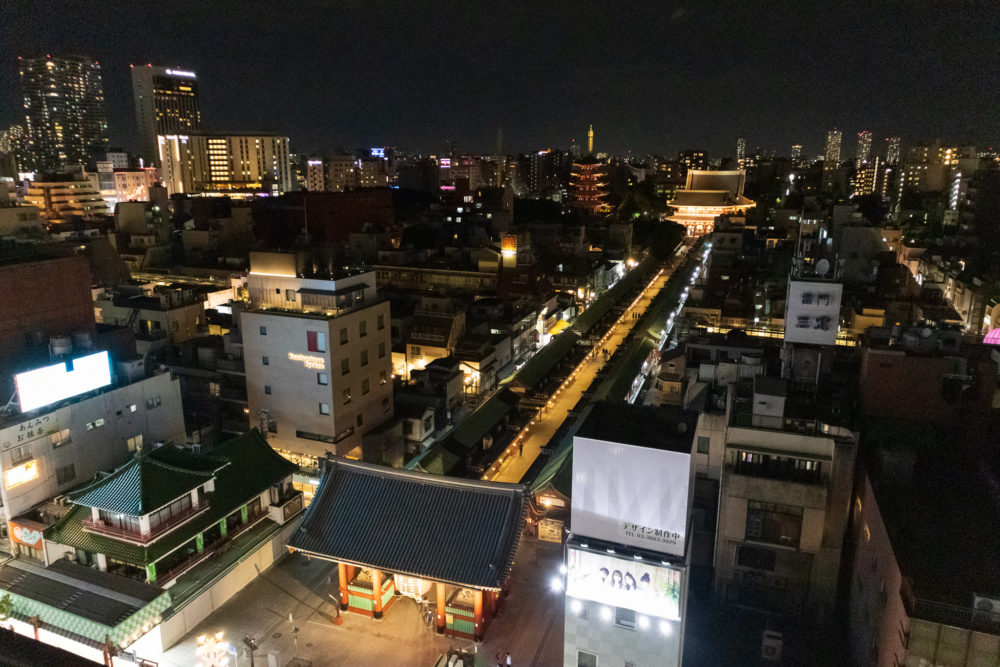
Asakusa Culture Tourist Information Center is a tourist information facility in Taito Ward. This facility is located across the street from Kaminarimon Gate. It should take about 1 minute from Asakusa Station on the Ginza Line (Exit #1).
This facility has a free observation terrace on its 8th floor that is open until 10 p.m. From this terrace, you can glance at Sensoji Temple, like in the above photo.

You can also see Tokyo Skytree from the observation terrace at Asakusa Culture Tourist Information Center. The view of Tokyo Skytree from such a high location is exceptional.
By the way, you can’t use a tripod on this terrace. Please be aware of that.
Kaminarimon Gate
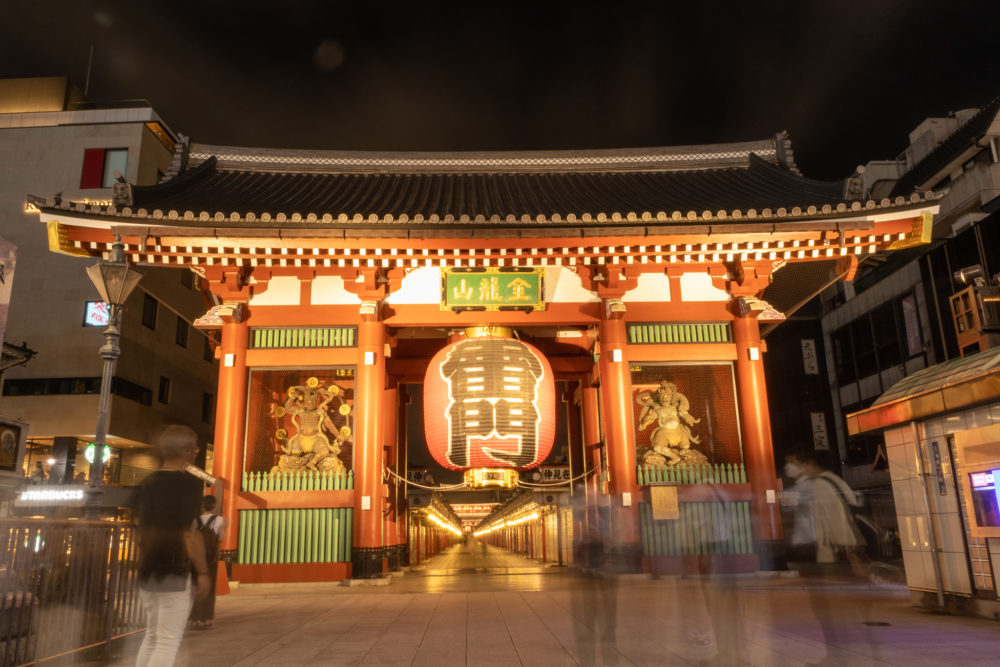
Kaminarimon Gate (the Gate of Thunder) is the first main gate of Sensoji Temple. When you hear the words “Asakusa” or “Sensoji Temple,” you might think of this gate. This gate is a popular photo shooting spot; it’s always full of tourists during the day.
The official name of this gate is Furaijinmon Gate (the Gate of Fujin and Raijin). This gate enshrines Fujin (the Wind God) on the right and Raijin (the Thunder God) on the left. Both Fujin and Raijin are the guardian gods of Buddhism.
For your information, you can find Starbucks Coffee on the left side of Kaminarimon Gate. This shop sells limited items featuring Kaminarimon Gate.
Asakusa-Nakamise-Dori Shopping Street

Asakusa-Nakamise-Dori Shopping Street is a shopping street that connects Kaminarimon Gate and Hozomon Gate of Sensoji Temple. This street is about 250 meters long and has about 90 souvenir shops.
Asakusa-Nakamise-Dori Shopping Street is the oldest shopping street, with over 300 years of history, according to them.
Most shops close by 6 p.m. on Asakusa Nakamise-Dori Street. The shutters of each shop are painted with murals called “Asakusa Emaki” (the picture scrolls of Asakusa). Seeing these murals at night is one of the pleasures of the Asakusa area.
Denboin-Dori Street

Denboin-Dori Street is another shopping street that crosses Asakusa-Nakamise-Dori Shopping Street from east to west. There are also many souvenir shops and restaurants on this street.
The streetlights on this street feature “Jiguchi Andon” (Jiguchi lanterns). Jiguchi was a popular word game during the Edo period. It might be a good idea to take a look at each one.

Denboin Street is also a photo spot for Tokyo Skytree. When facing east from this street, you can see the tower, like in the photo above.
In addition, real-scale dolls of characters from the Kabuki play “Shiranami Gonin Otoko” (Five Men of the White Waves) are placed here and there on Denboin Street. For example, in the photo above, you can find one sitting on the roof of the shop on the right.
The reason why such dolls are placed here is that Kawatake Mokuami, the author of “Shiranami Gonin Otoko,” lived near this street.
Hozomon Gate and the Five-Story Pagoda
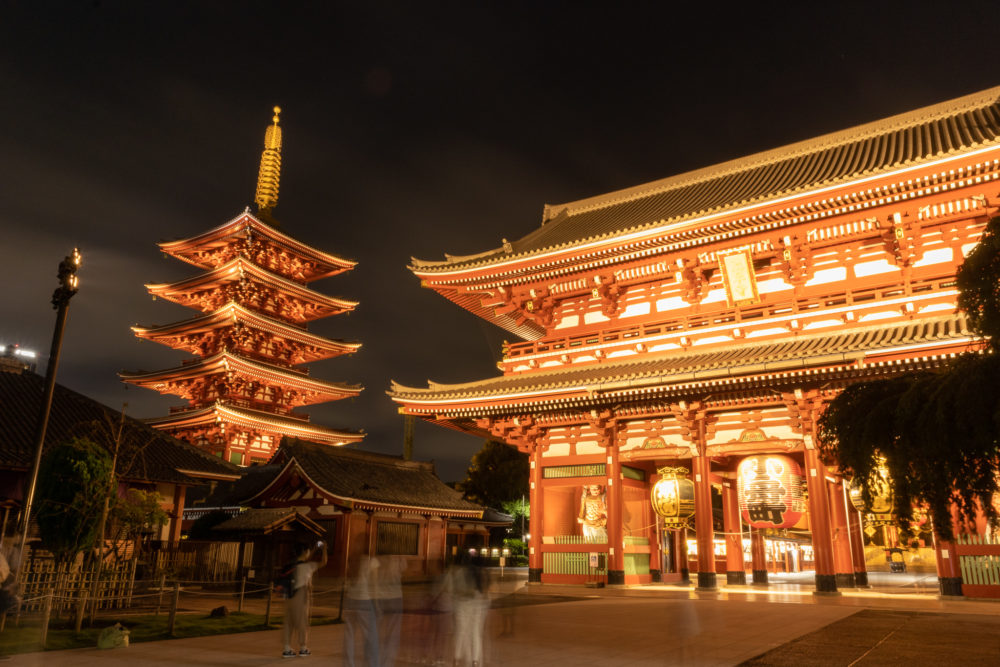
If you pass through Asakusa-Nakamise-Dori Shopping Street, you will arrive at Hozomon Gate. This two-story gate enshrines two statues of Nio, another guardian god of Buddhism. For this reason, Hozomon Gate used to be called Niomon Gate (the Gate of Nio).
On the second floor of Hozomon Gate, Sensoji Temple keeps Buddhist sutras known as “Genban Issai Kyo,” important national cultural properties.
For more detail about Hozomon Gate, please refer to the following blog post:
You can find a five-story pagoda in the photo above.
According to Sensoji Temple, this pagoda was first built in 942. It was initially a three-story pagoda at that time, but Sensoji Temple rebuilt it as a five-story pagoda in 1648.
The five-story pagoda has been burned and rebuilt repeatedly. Sensoji Temple rebuilt the current pagoda in 1973.
On the top floor of the five-story pagoda, Sensoji Temple keeps Busshari. Busshari are the remains of Buddha, the founder of Buddhism.
The Main Building of Sensoji Temple
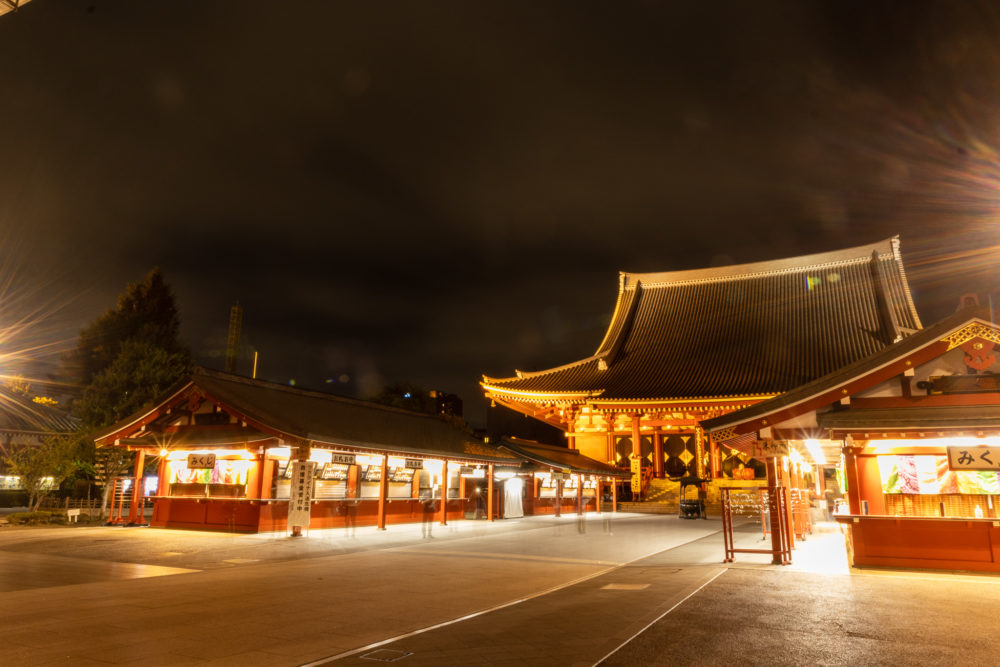
After passing through Hozomon Gate, you will finally arrive at the precincts of Sensoji Temple. Sensoji Temple’s main hall is also known as Kannon-Do Hall because it houses Sho-Kannon Bosatsu.
Kannon-Do Hall was initially built in 628. Since then, it has been burned and rebuilt repeatedly, like other properties of the temple. The current hall was rebuilt in 1958.
The opening hours of the main hall of Senso-ji Temple are as follows:
- 6 a.m. to 5 p.m. (April to September)
- 6:30 a.m. to 5:00 p.m. (October to March)
But you can pray at the main hall even when it is not open.
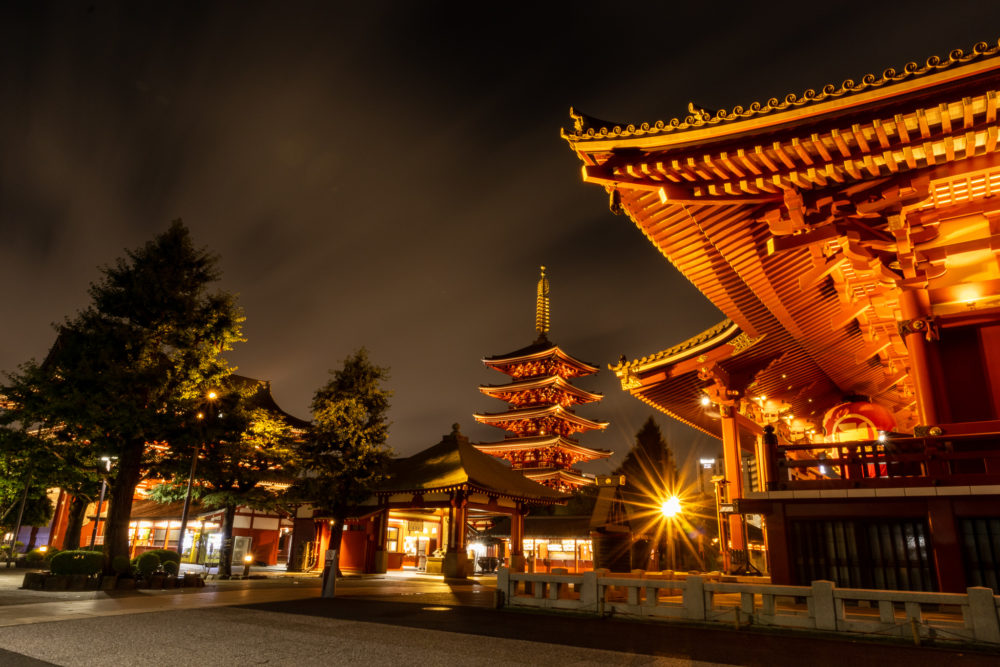
This is the main hall of Sensoji Temple, seen from the right. From this location, you can see the main hall, the five-story pagoda, and Chozuya at the same time. Chozuya is a facility where you rinse your hands and mouth to purify before worshipping deities.
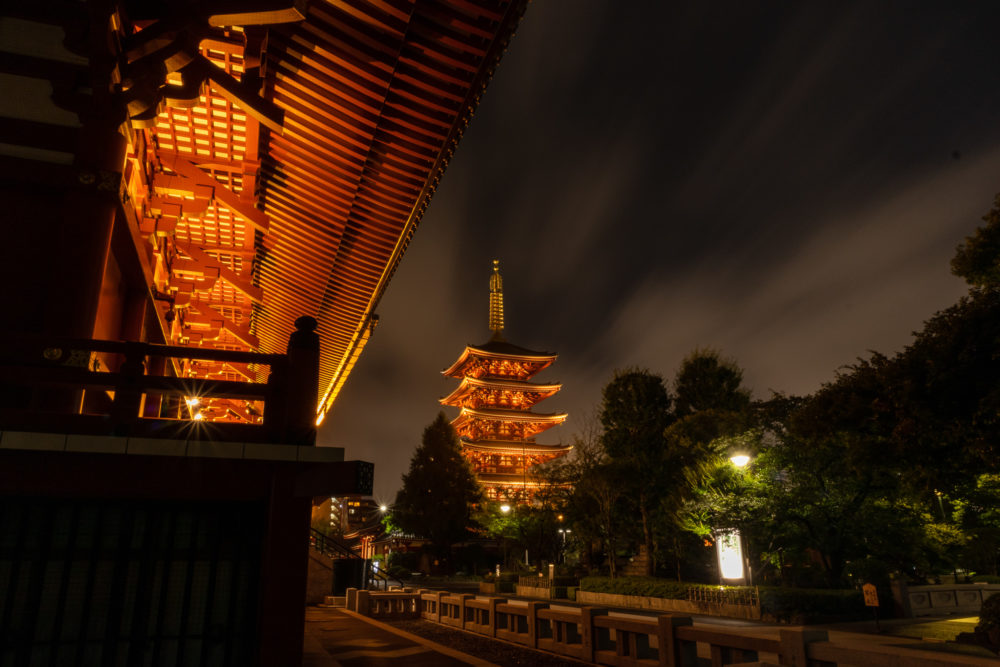
We took this photo behind the main hall of Sensoji Temple. This is our favorite photo spot.
You can take a picture of the main hall and the five-story pagoda at the same time. And there is also a creek running to the right of this photo. The music of the creek makes our minds peaceful.
Okuyamamon Gate
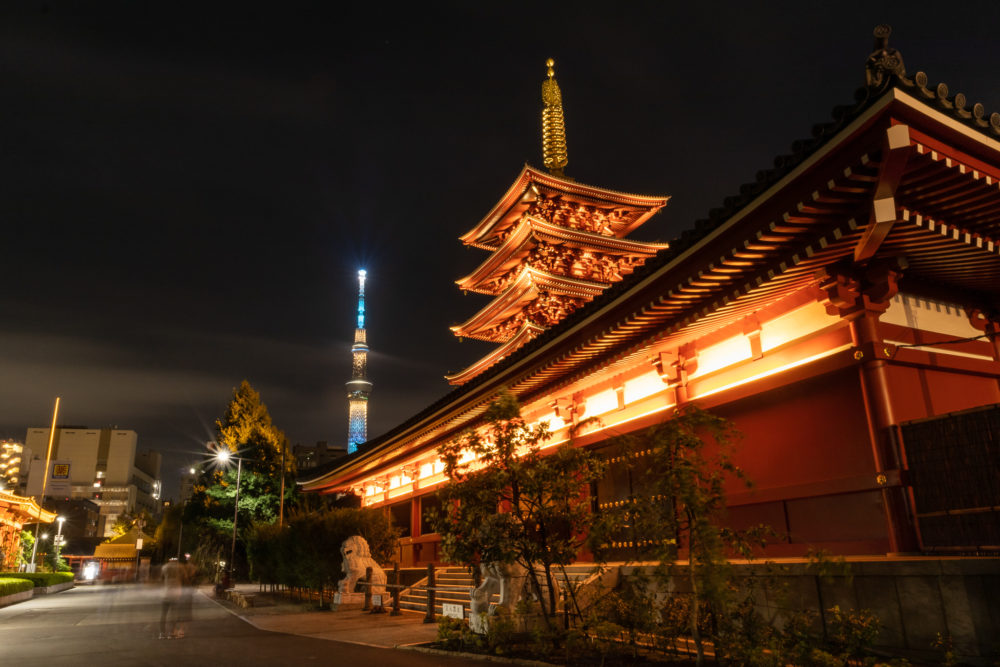
Okuyamamon Gate is on the left side when you look at the main hall from the front. If you pass through this gate, you will arrive at Okuyama Omairi Shopping Street.
From Okuyamamon Gate, you can see the five-story pagoda and Tokyo Skytree at the same time. This is also our favorite photo spot.
Yakushi-Do Hall
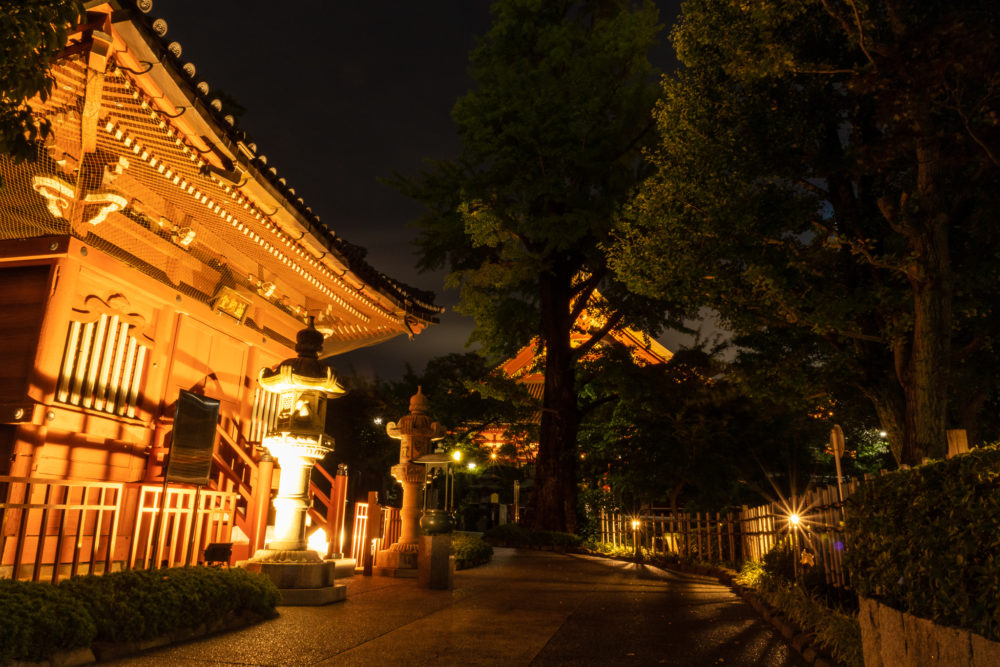
Yakushi-Do Hall is located on the west side of Sensoji Temple’s precincts. Awashima-Do Hall and Yogo-Do Hall are near this hall.
According to Sensoji Temple, Tokugawa Iemitsu, the third shogun of the Tokugawa dynasty, built Yakushi-Do Hall in 1649. This hall used to be behind the main hall but was moved to its current location in 1994.
As its name indicates, Yakushi-Do Hall enshrines Yakushi Nyorai, the Medicine Buddha. This Buddha is well-known for its divine healing powers, particularly in the treatment of eye diseases.







